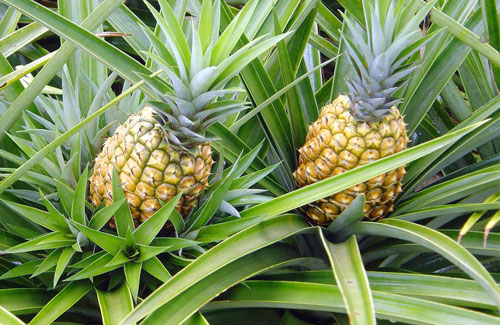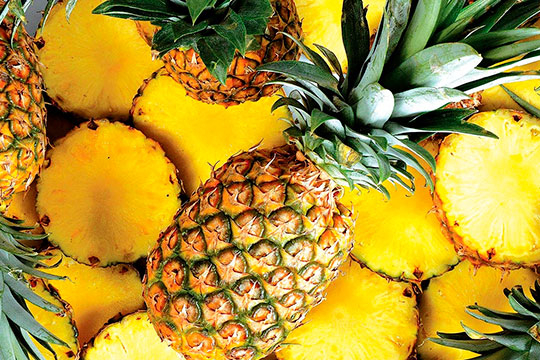
Greetings to all the readers of this HIVE community, I want to thank you once again for your comments and your votes. This time I want to talk about a fruit called pineapple and I know that for many it is a very strange fruit and a little difficult to peel and it has that very pointed crown and Spinoza but inside it is a fruit with a sweet and very tasty flavor. But today I have a reflection for you based on this characteristic of this fruit.

Reflection on life: everything in life has a meaning and a reason, but many times there are people who do not seek the meaning of life or what they do to leave a mark that marks other people. For a very colloquial word is to be TOXIC, a person of this denomination is that it is like a pineapple, very difficult to peel and has many thorns because it does not have a crown!
Life takes many turns and we do not know what awaits us tomorrow. These types of people are people that we should be very close to us, these types of people will always have a different vision than the one we have and they are also people who should see things differently, they are negative people and just like the crown of the pineapple is a bit spiny and won't let go. People who always have a negative mindset are people who oppress our thoughts to see the future like this. If you have to keep those people away from us until they understand that everything has an effort to be successful. The pineapple after that peeled only remains to eat the candy that is inside it.

Here I leave the investigation of the fruit:
The tropical pineapple, pineapple or American pineapple is a highly appreciated fruit for its exquisite flavor and delicate aroma, which also surprises for its famous therapeutic virtues, some of which have yet to be demonstrated.
Pineapple is a tropical fruit with excellent flavor and great properties, rich in potassium and low in calories.
The pineapple is the fruit of a plant native to South America, known as pineapple. In fact, the Portuguese continue to know it by this name, which in the indigenous language meant "excellent fruit".
It was Christopher Columbus who brought it to Spain in 1493 after his second voyage and it was the Spanish explorers who gave it the name pineapple because of its resemblance to the fruit of the pine.
Its flavor, its fragrance and its appearance soon gained adherents, but its cultivation did not give the desired result. For this reason, both Spanish and Portuguese decided to cultivate it better in their colonies.
For a long time, this fruit was appreciated by the noble classes and exalted as a symbol of elegance and hospitality. But it was not until the beginning of the 18th century, when the first crops were obtained in Holland and England and little by little it spread throughout almost all of Europe, using greenhouses in many places in order to adjust the temperature and thus facilitate its cultivation.
In the 19th century, its crops spread throughout Australia, South Africa and Hawaii. Currently, most of the pineapples consumed in Europe come from South Africa and Hawaii, considered one of the main producers of pineapples in the world, together with Thailand and Brazil.

The pineapple is a compound fruit, formed by the union of the fruits of several flowers around a fleshy axis. There are many varieties of pineapple, although they have similar characteristics.
Some specimens can reach 2 kg in weight, they generally have an oval shape and their yellow or white pulp is protected by a hard skin with scales, with an upper end decorated with striking green leaves as a of crown.
Most consumed pineapple varieties in Spain:
- Spanish red or purple (Red Spanish). Its fruit is almost round with thick orange skin and white or pale yellow pulp. It is characterized by its pleasant, intense and acid aroma.
- Smooth Cayenne (Smooth Cayenne). It does not have thorns (smooth) and its fruits are large and cylindrical. The cayenne is dark yellowish orange in color and has a light yellow or a beautiful golden hue flesh.
- Emerald. With similar characteristics to the Smooth Cayenne, it has a very light yellow, almost white, pulp.
- What in. It is one of the oldest varieties, it is grown mainly in South Africa. Its fruit has an almost spherical shape, a yellowish gold color and intense yellow pulp. It is not very juicy, but it has an extraordinary aroma and it keeps very well.
- Sugar loaf. It is one of the most appreciated varieties for its sweetness and juiciness.
- From Mount Gold. It has an "extra-sweet" flavor, a golden color and a higher content of vitamin C. Its skin is thicker and heavier than other varieties.
Pineapple, rich in vitamin C and potassium
Pineapple has a high water content and a low caloric value.
Thus, 100 grams of pineapple provide only 55 calories. This caloric intake is due to its carbohydrate content, since the percentage of fats and proteins is almost negligible. - Carbohydrates. Pineapple contains about 11% carbohydrates, most of which are sugars. These sugars (mainly sucrose and fructose) are fast assimilation carbohydrates and their content increases as the fruit ripens.
- Lipids or fats. It barely contains fat, 100 grams of pineapple contains 0.2 grams of fat.
- Proteins. Like fat, pineapple hardly contains protein, its content being almost insignificant (0.4 grams per 100 g of pineapple).
- Fiber. Its fiber content is not very high, about 1.5 grams per 100 grams of food, but enough to give it a certain laxative effect and help regulate intestinal functions.
- Vitamins. Pineapple is rich in vitamins, mainly in vitamin C, and to a lesser extent in vitamin B1, B6 and folic acid. Vitamin C, in addition to performing important functions and being, for example, involved in its defense mechanisms, favors the absorption of iron by the body.
- Minerals. Regarding its mineral content, the presence of potassium stands out and, to a lesser extent, magnesium, iron, copper and manganese. A typical serving of 200 grams of pineapple can cover 9% of the recommended daily needs for potassium.
- Non-nutritive components. Among its non-nutritive components, the presence of citric and malic acids stands out, responsible for its acid taste and enhancers of the action of vitamin C on the absorption of iron from the diet.

Pineapple, more than a food
Among its non-nutritive components, pineapple contains bromelain, an enzyme similar to digestive enzymes that helps digest protein. Bromelain, of a protein nature like the rest of the enzymes, performs its action in the stomach and intestine, facilitating the digestion of proteins. This enzyme breaks down the protein molecule into smaller ones and releases amino acids that are absorbed by the body. Its action is such that the food industry uses bromelain to soften meat.
However, bromelain deactivates with temperature, so it is difficult for it to be present in preserved or canned pineapples, which have been subjected to the action of heat. To appreciate the properties of bromelain, it is necessary to take fresh pineapple.
In addition to this proteolytic action, many more therapeutic properties are attributed to bromelain, although not all of them are scientifically proven. It seems proven that bromelain: - Inhibits platelet aggregation preventing the risk of cardiovascular disease.
- It is anti-inflammatory and diuretic and, as such, very useful in inflammatory processes, edema, and to prevent fluid retention, hence its use in anti-cellulite treatments.
- It is mucolytic, and thins the mucus that accompanies bacterial infections, bronchitis and sinusitis.
Based on these properties, bromelain is prescribed in natural medicine in the form of tablets and its excellent results are reported in the treatment of rheumatoid arthritis and obesity, among other pathologies.
However, it is necessary to take into account that the consumption of pineapple is not recommended in people suffering from gastroduodenal ulcer and gastritis due to its acid content and its ability to increase the production of gastric juices, which would cause a worsening of the symptoms. .
Pineapple a most versatile food
The pineapple ripens satisfactorily only if it is on the plant, where it usually doubles its sugar content during the last stage of ripening. If it is collected when it is not yet ripe, it has an acid taste and is poor in nutrients.
When buying it in the market, it should be taken into account that a good quality pineapple is ripe when: - Its pulp yields slightly when exerting gentle pressure with your fingers.
- Its aroma is intense.
- The tips of the leaves are orange and can be pulled off relatively easily.
- The skin is a uniform orange-yellow color. If it has a rather greenish color, the piece is immature and if it has brown spots, the pineapple is "stale"
As for its uses, although the best way to take advantage of its nutritional properties is to consume it naturally, either alone or accompanied, the gastronomic use of pineapple is very varied and numerous.
Thus, it can be seen preserved in syrup, resulting in much more calories than natural, or cooked or baked, which intensifies its aroma and flavor, in confectionery as an ingredient in cakes, pies and jams, or in the form of juice. , alone or accompanied by other fruits.
The great versatility and the perfect combination of its flavor with that of other foods, does not relegate it exclusively to the preparation of desserts but it appears in a multitude of dishes, forming part of starters, salads, seafood dishes, with meats with such an intense flavor such as pork or duck, in vegetables and even in cocktails.
Learn more about pineapple
Pineapple is very sensitive to changes in temperature. It should not be stored in the refrigerator since it cannot withstand temperatures below 7ºC, losing all its flavor and aroma.
The life of many people can be like this very difficult pineapple to peel and Espinoza situations like the crown of this pineapple. Well I hope they are of benefit and blessings. onderzoekslink: https://www.lechepuleva.es/aprende-a-cuidarte/tu-alimentacion-de-la-a-z/p/pina
Leave your comments and your votes….